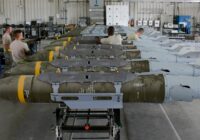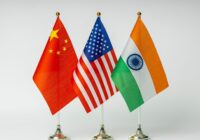When it came to race, climate or diplomacy, Obama was like a visitor from the future. On trade and intervention, however, he was often stuck in the past.
For Barack Obama supporters, the last eight years have been a victory of wise leadership over the forces of darkness in Congress and the world at large. For critics of the outgoing president, Obama could do no right as he plunged the United States into the worst crisis in its 200-plus years of history.
Between the high notes of Obama’s farewell address and the low rumble of Donald Trump’s tweets, it can be hard to find a middle ground.
The Washington Post has attempted just such an even-tempered appraisal of the Obama era. In a stand-alone section from January 11 entitled “Obama’s Legacy,” also issued as an e-book, The Post asked more than a dozen journalists and pundits to weigh in on the different facets of the president’s tenure in office—from his efforts to pull the economy out of financial crisis to his more recent foreign policy accomplishments.
Each of the contributions is structured, appropriately, around a call and response: The president achieved this but failed to achieve that.
Obama brought the country back from the brink of economic disaster, but he could have pumped more money into the recovery and implemented more thoroughgoing financial reform. He pushed through universal health care, but the plan had too little support from Congress and too much buy-in from the insurance industry. He addressed climate change, but it wasn’t enough to stop the planet from heating up. He promised peace but he continued wars.
President Obama himself encouraged such a measured evaluation, for he was always trying to present more complex pictures to the American public.
The Post section begins with several essays on Obama as the first black president. That remarkable precedent became less and less important as he tackled a succession of urgent problems in his first year. Yet for a significant portion of the American electorate, Obama’s racial identity never ceased to be relevant.
The African American community rooted for him—“Black America has held its collective breath during every second” of his presidency, writes Michael Eric Dyson—as strenuously as racists hoped that he would fail. The notion that Obama was born in Africa, that he was a secret Muslim, that he was an angry anti-colonialist in disguise—these arguments achieved a measure of traction only because of the intractable racism of American society. For much of the US, President Obama remained incorrigibly “other.”
After Trump’s surprise victory in November 2016, Obama told David Remnick of The New Yorker something quite interesting: “I probably showed up 20 years sooner than the demographics would have anticipated.” By 2028, Obama was implying, a swelling non-white electorate would finally have the power to elevate a non-white candidate to the White House. Obama’s youth, his outsider status, his eloquence: All of these qualities allowed him to jump the queue. So much of the resistance to his presidency—and the ultimate victory of Donald Trump—can be explained as well by this kink in the fabric of time.
A president from the future arrived to govern with preternatural calm—and we just weren’t ready for it. Half the country couldn’t wait to elect an old man peddling an imaginary past.
The President and the World
After Obama won his second term, I cautioned that the president would have a hard time achieving any of his foreign policy goals:
“The record so far suggests that the president likes to make important game-changing speeches — on re-engaging the Muslim world, on nuclear abolition — but is not willing to put in the monumental effort to implement these visions. For instance, he rhetorically distanced his counter-terrorism policies from his predecessor’s. But he then went on to expand drone warfare both in scale (in Pakistan) and scope (Yemen and Somalia). Despite his much-vaunted willingness to negotiate with America’s adversaries should they show a willingness of their own, the president demonstrated considerable skittishness once in office. Early opportunities to engage with North Korea, Iran, and the Taliban were squandered.”
Four years later, the president can point to several victories that he snatched from the jaws of congressional defeat: the Iran nuclear deal, the détente with Cuba, the Paris climate accord. In his farewell address, Obama referenced all of these victories—as well as his having “taken out tens of thousands of terrorists, including bin Laden”—but he didn’t dwell much on foreign policy. He focused instead on values, principles, “the power of ordinary Americans to bring about change.” He sounded more like the philosopher-in-chief than the commander-in-chief.
Obama might have slighted international relations in his last major address because of the widespread perception that the world is a scarier place today than it was when he took office.
 “My position is that the United States is much worse off today than it was in 2009, when Obama became the president,” opines political scientist John Mearsheimer. He points to the Middle East where “except for the Iran nuclear deal, under President Obama we have helped create a zone of disaster.” It’s certainly true that Syria was more-or-less stable in 2009 when Obama took office. Libya, once similarly frozen in autocracy, is no great shakes today either. The rise of the Islamic State, the refugee crisis, the expansion of Israeli settlements in Palestinian territory, the disintegration of Yemen, the expansion of drone attacks: all of these took place on Obama’s watch.
“My position is that the United States is much worse off today than it was in 2009, when Obama became the president,” opines political scientist John Mearsheimer. He points to the Middle East where “except for the Iran nuclear deal, under President Obama we have helped create a zone of disaster.” It’s certainly true that Syria was more-or-less stable in 2009 when Obama took office. Libya, once similarly frozen in autocracy, is no great shakes today either. The rise of the Islamic State, the refugee crisis, the expansion of Israeli settlements in Palestinian territory, the disintegration of Yemen, the expansion of drone attacks: all of these took place on Obama’s watch.
Not that Obama must shoulder all the responsibility for this mess. The Middle East had already been destabilized by the 2003 invasion of Iraq. When Obama took office in 2009, anger was rising throughout the region at the dictators that the US was supporting: Hosni Mubarak in Egypt, Zine el-Abidine Ben Ali in Tunisia, the Khalifa family in Bahrain, the Saud family in Saudi Arabia. Benjamin Netanyahu was just coming to power in Israel, making peace with Palestine a long shot at best.
What could Obama have done that was different? Double down on the Iraq occupation? That would have been wildly unpopular and broken one of his main campaign pledges. Withdraw immediately from Iraq? That would have thrown the country into a civil war not unlike what overtook Syria. When the Arab Spring protests broke out, Obama tried to have it both ways: support Mubarak in Egypt until his rule was obviously untenable; lead from behind in Libya to avoid what might have been a large-scale atrocity; and provide some support for anti-Assad rebels in Syria while avoiding a full-scale commitment.
He was condemned to these half measures because, frankly, the developments in the region were beyond US control. Complaints of Obama’s fecklessness were, in fact, veiled acknowledgments of the declining power of the United States.
Sure, Obama should have demilitarized the US relationship with the Middle East. He could have provided a significant Marshall Plan-sized assistance program to all of the countries in the region exiting authoritarian regimes. He could have fundamentally transformed the US role in the world. But Obama was not a bold actor—and he didn’t have support in Congress for such bold actions even if he had been predisposed to offer them.
Where Obama did take initiative, he acted with public opinion behind him: on Iran, on Cuba, on climate change. He was a canny politician in this sense, always cognizant that he was ahead of the demographic curve. He was always dancing between innovation and tradition. Schooled in the social work tradition, he started where the client was.
Obama was an internationalist, in the best and worst senses of the term. He supported diplomacy, the United Nations, multilateral cooperation. But he was also committed to free trade, the institutions of economic globalization, and US military force in the service of these and other goals. For all his intelligence and agility, he was a prisoner of this tradition, dependent on the cooperation of allies and subservient to the most powerful actors in the global economy like banks and corporations.
Nothing exemplified that approach more than his attempt at a Pacific pivot.
Pacific Pivot
The Middle East is the past. It’s full of conflict. The leadership in the region is largely autocratic. The major resource is oil and cheap labor, a very 19th-century combination. It’s no surprise that the forward-looking Obama was devoted to redirecting the focus of US foreign policy away from a region so thoroughly disrupted by his predecessors and toward the lands of opportunity in the East.
The Pacific pivot consisted of two main aspects—a rearrangement of US force posture in the region and the Trans-Pacific Partnership (TPP), a new free-trade agreement—designed primarily to contain China militarily and economically. The administration failed at both.
The TPP was a casualty of the presidential election as Donald Trump blasted the agreement and Hillary Clinton disavowed her earlier support. Even before the campaign got underway, the military realignment didn’t really take place either, except for some largely symbolic weapons transfers, an upgrade in missile defense, and the redistribution of some Marines from a base in Okinawa to other spots in the region. Not only was China not particularly constrained by these actions, but it achieved a major recent victory by cultivating a new relationship with the Philippines and its new leader, Rodrigo Duterte.
For some realists, like Mearsheimer, Obama’s failure to pull America away from the Middle East rendered the US incapable of addressing China more forcefully.
“Because China is a potential peer competitor, it is the most serious threat facing the United States at this point in time, and therefore we should be focusing much more attention on China than on the Islamic State [ISIS or IS], which is hardly a mortal threat to the United States. I might also add that by staying deeply involved in the Greater Middle East and using military force in all sorts of places, what we end up doing is making the terrorism problem worse, not better. What we ought to do is reduce our footprint in the Middle East, which will go a long way toward ameliorating the terrorism problem and also allow us to pivot to Asia.”
Pivot to Asia to do what exactly? Make a mess of things there as well? Further encourage a right-wing government in Japan to reestablish military power in the region? Twist North Korea’s arm a little more? Confront China in its front yard of the South China Sea? Penetrate into markets of the region more forcefully than Chinese capitalists?
Pivoting to Asia, given its concentration of wealth and technological prowess, is a fine idea. But Obama’s version was flawed.
In any case, Trump seems about to pick up the fumble and run with it. As Josh Rogin wrote recently in The Washington Post:
“Behind the scenes, however, the Trump transition is preparing its own pivot to Asia. As the team that will implement that policy takes shape, what’s emerging is an approach that harkens back to past Republican administrations — but also seeks to actualize the Obama administration’s ambition of enhancing the U.S. presence in the region. Transition officials say the Trump administration will take a hawkish view of China, focus on bolstering regional alliances, have a renewed interest in Taiwan, be skeptical of engagement with North Korea, and bolster the U.S. Navy’s fleet presence in the Pacific.”
So might the Trump transition team look at Asia, but it’s unlikely that these best-laid plans will survive the first months of the new administration. Trump will learn, once in office, the realities of the US-China relationship and how difficult it is to push too hard against a country that has so much economic leverage over the United States.
And if Trump follows through on his promise to focus on the Islamic State, he will likely become as thoroughly enmeshed in the Middle East imbroglio as his predecessor. It is one thing for Trump to destroy what Obama built—the Iran deal, Obamacare—but it’s quite another for him to build something durable. Much of what Trump has touched in the past, after all, has gone bankrupt.
When it came to race relations or climate change or building a cooperative relationship with former adversaries, Barack Obama was indeed a visitor from the future. Just as often, however, he appeared to be a visitor from the past, reminding Americans of the virtues of containment, of balancing great powers, of trying to use brute force to subdue enemies. Governing alternately in these two tenses, Obama was both ahead of his time and behind it. He now gives way to a man with no vision, no sense of history, someone caught in the eternal now of Twitter.
Obama’s legacy and our well-being are now, for the time being, in Trump’s hands. No doubt many people would like to get a hold of Obama’s time machine to skip over the next four years as quickly as possible.
*[This article was originally published by FPIF.]
The views expressed in this article are the author’s own and do not necessarily reflect Fair Observer’s editorial policy.
Photo Credit: The White House
Support Fair Observer
We rely on your support for our independence, diversity and quality.
For more than 10 years, Fair Observer has been free, fair and independent. No billionaire owns us, no advertisers control us. We are a reader-supported nonprofit. Unlike many other publications, we keep our content free for readers regardless of where they live or whether they can afford to pay. We have no paywalls and no ads.
In the post-truth era of fake news, echo chambers and filter bubbles, we publish a plurality of perspectives from around the world. Anyone can publish with us, but everyone goes through a rigorous editorial process. So, you get fact-checked, well-reasoned content instead of noise.
We publish 2,500+ voices from 90+ countries. We also conduct education and training programs
on subjects ranging from digital media and journalism to writing and critical thinking. This
doesn’t come cheap. Servers, editors, trainers and web developers cost
money.
Please consider supporting us on a regular basis as a recurring donor or a
sustaining member.
Will you support FO’s journalism?
We rely on your support for our independence, diversity and quality.







